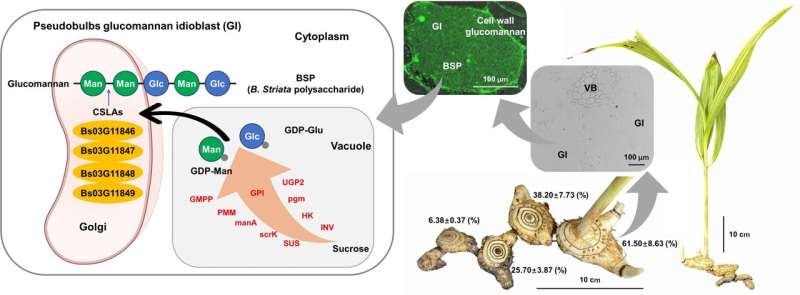
The dry pseudobulb of the plant Bletilla striata Rchb. f. (Orchidaceae), spelled BaiJi in Chinese as an important traditional Chinese medicine, has the effects of astringent hemostasis, detumescence, and promotion of muscle growth.
The soluble, non-cellulosic polysaccharide is the main active ingredient of B. striata (BSP) for its hemostatic, antibacterial, antitumor, antifibrotic, wound healing, antioxidant aging, and other medicinal effects.
It can also be used as an excellent biopolymer material and pharmaceutical excipient. However, the composition, cytological distribution, and biosynthesis molecular mechanisms of active polysaccharides in Chinese herbs, including BSP, are still poorly understood.
Researchers from the Wuhan Botanical Garden of the Chinese Academy of Sciences (CAS) have analyzed the content, composition, distribution, and biosynthesis of BSP, obtained candidate enzyme genes involved in BSP biosynthesis, and characterized the cellulose synthase-like family A (CSLA) gene family in the glucomannan polymerization of the cell wall and BSP.
The results show that BSPs are water-soluble polysaccharides deposited only in the pseudobulb of the medicinal tissue, with a mass ratio of approximately mannose:glucose=3:2, and are distributed in the cytoplasm outside the vacuoles, which can be significantly differentiated from glucomannan in cell wall fractions.
The study, titled “Cytochemical localization and synthesis mechanism of the glucomannan in pseudobulbs of Bletilla striata Reichb. f,” was published in Horticulture Research.
There are 12 enzyme families involved in the biosynthetic pathway from sucrose to glucomannan. The researchers identified the BSP-related genes and suggested that the functional differentiation of the CSLA subfamily may be the key to the flow of glucomannan to intracellular polysaccharides or cell wall hemicellulose fractions.
Four CSLA family members of a gene cluster, Bs03G11846, Bs03G11847, Bs03G11848, and Bs03G11849, can form homo- or heterodimers that affect BSP synthesis in the B. striata pseudobulb.
The results provide genetic resources and theoretical basis for the creation, development, and utilization of new and excellent germplasm of B. striata.
More information:
Junfeng Huang et al, Cytochemical localization and synthesis mechanism of the glucomannan in pseudobulbs of Bletilla striata Reichb. f, Horticulture Research (2024). DOI: 10.1093/hr/uhae092
Provided by
Chinese Academy of Sciences
Citation:
Study dissects histochemical localization and biosynthesis molecular mechanisms of Bletilla striata polysaccharides (2024, June 21)
retrieved 25 June 2024
from https://phys.org/news/2024-06-histochemical-localization-biosynthesis-molecular-mechanisms.html
This document is subject to copyright. Apart from any fair dealing for the purpose of private study or research, no
part may be reproduced without the written permission. The content is provided for information purposes only.




